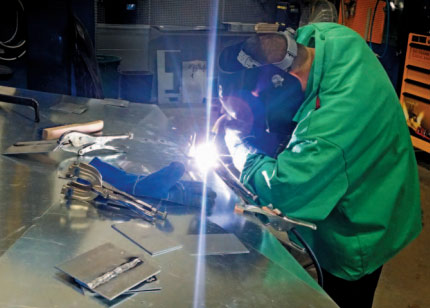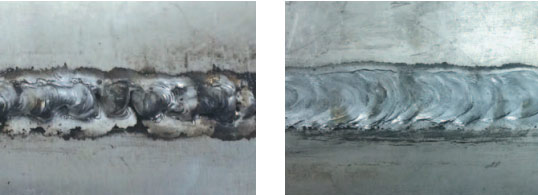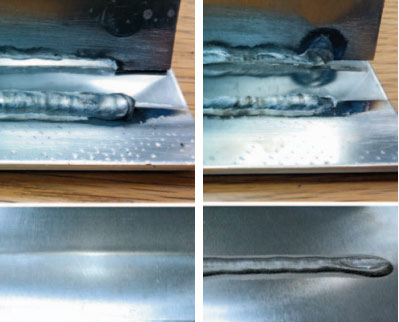- Track your orders
- Save your details for express checkout
What Is Your Weld Telling You?
Listening and Learning from it can make you better at the skill
Article by Jeff Coops / Contributing Editor Car-O-LinerFor further Car-O-Liner articles visit www.car-o-liner-us.com/resources/articles
As materials used in new vehicle construction keep advancing, welding equipment and repair techniques must also evolve. For example, how many of us had heard of ER5554 aluminum wire until Ford rolled out the new F-150? Or thought of MIG brazing for structural repairs like Honda specifies in certain situations for their 1500 MPa parts? Or really understood the diff erence of Pulse MIG welding?
You may be thinking that aluminum and silicon bronze MIG welding aren’t new; they’ve been around for decades. So why are they suddenly drawing so much attention? First, advanced materials have become more prevalent. Now being used in higher volume vehicles, everyone will likely come in contact with them at some point. Second, a shift in use from primarily cosmetic to structural applications means proper repair procedures are now critical. Finally, because just like the equipment, the technician also must be willing to adapt.

Practice is the key to perfecting your technique.
MIG/MAG welding in general requires much more skill than spot welding because of the human factor. The angle of the torch, how quickly and in which direction you move your hand, the distance from the work piece, temperature, weld settings, speed movement, etc. all affect the weld. Standard MAG welding of mild steel is pretty forgiving where the newer materials are not. The technique required is quite different and the “this is the way I’ve always done it” attitude is not going to work.
Watching a skilled welder is like observing an artist or a professional golfer. The process appears effortless and under complete control. Generally that ease comes from lots of practice. For the rest of us, who are not welding regularly, it can be a frustrating struggle when results are not as expected. You start thinking, “Is the problem the machine, did I set something wrong, is this wire bad, or the gas? Is it me? What am I doing differently?” With so many variables, it can be difficult to identify how to begin troubleshooting a problem. Watching the arc and listening to the sound may give some ideas, but the process is so quick that it is difficult. Examining the completed weld is an excellent indication of what is happening and where to begin.
In MIG/MAG welding, the wire speed, current, and voltage all work together with the shielding gas to create the perfect weld conditions. Inspecting the weld results, we are looking for indications of which of the key elements of the weld are off. As we know, they are interrelated, so there is some crossover. However, typically one symptom will be more pronounced. For every symptom there are a number of factors that could cause that result. Those factors can be thought of as falling into one of four areas:
• Technique
• Settings and Software
• Consumables and Wire Feed System
• Welding Machine
This is the order in which the problems typically occur. Troubleshooting them this way puts the focus on the most common faults first, which also are the ones easiest to control. For the sake of this exercise, we will focus on synergic welders and primarily aluminum weld faults.
Let’s first consider GAS FLOW
Shielding gas performs a number of functions critical to the weld. It protects the weld pool from contamination. It also supports and stabilizes the arc, acting as a gaseous conductor. And, it helps control the weld bead appearance. If the shielding gas is too low or completely missing, the weld is very sooty, often embedded in the bead. The welding equipment appears to be running very hot and resembles a plasma cutter rather than a welder. Porosity in the weld is another indication of low gas. On the other end of the spectrum, too much gas causes a rough surface of the bead, particularly around the edges. The excessive flow results in turbulence at the end of the gas nozzle sucking air into the envelope.
Amperage Too Low (left), Amperage Too High (right)
SYMPTOM: “GAS FLOW LOW”
Following are factor – cause.Technique – Torch angle is not steep enough, approximately an 80° angle
• The gas is not pushing into the area to be welded
• Torch is too far away from the work piece (torch standoff)
• Fans or a draft stealing the gas
Software / Settings – Improper gas flow setting, 25CFH (12l/min) is typical for 1.2mm ER5554
Consumables / Wire Feed System – Blocked gas nozzle
• Bad gas flow regulator, use a Flow Tester to check accuracy at the nozzle
• Empty gas bottle
Welding Machine – Defective air solenoid valve
• Damaged torch assembly

Example Shielding Gas Symptoms: No Gas Flow (left), Gas Flow Too Low (middle), Gas Flow Too High (bottom)
Another key component of a proper weld is the WELDING CURRENT.
Standard controls include separate wire feed speed and power settings where on synergic machines those parameters are set together. While the parameters are built into the unit, there is still the potential for error that affects that ratio. It could be something dragging on the wire affecting the wire speed or the aluminum not cleaned properly driving up the resistance. The result is the balance is off and the welder is described as running “too hot” or “the wire speed needs turned down”.When at the extreme, too much or too little current yield identifiable results. Too cold and the bead is sitting on top of the work piece with little or no penetration. Too hot and it is probably burning through. As you move towards the middle, you may need to examine the weld bead closer. If the current is too low and wire speed too high, the resulting weld bead is taller with steeper edges. When the current is too high and the wire speed is too low, the bead is flatter or concave. When working with steel, current too high shows up as undercutting and too low as overlapping. Aluminum is far more heat-sensitive, so typical penetration is only about one third the material thickness. This appears as a heat ripple. On aluminum, the most obvious sign of too much heat is burn through to the back of the piece.
SYMPTOM: “WELDING CURRENT HOT”
Following are factor – cause
Technique – Travel speed is too slow for the setting
• Work piece dirty or oxide layer not cleaned properly
Software / Settings – Incorrect starting settings
• Wrong weld program for the wire, ER4043 welds very differently than ER5356 and requires different settings
Consumables / Wire Feed System – Spatter in the contact tip creating drag on the wire
• Dust build-up in the wire liner restricting wire movement.
Welding Machine – Defective Power Supply
VOLTAGE is another parameter that contributes toward a proper weld. On synergic welders, the starting voltage is set along with the other parameters. All units provide a means of adjusting the voltage separately, at least to a certain degree. This changes the arc length or the distance from the end of the wire to the work piece. As voltage goes up, the arc lengthens, the bead gets wider, and penetration reduces. As the voltage is turned down, the arc shortens, the bead narrows, and the penetration deepens. This is very useful when working with thinner materials or when challenged by difficult welding positions. A shorter arc often works better on overhead welds.If the voltage is too far off it will show up in the weld bead appearance and ultimately in the weld penetration. When voltage is too high, the bead flattens out and loses texture. The wire may begin burning back into the contact tip. When the voltage is too low, the arc becomes too short. The droplet doesn’t have time to burn off before it contacts the weld pool causing more spatter than usual for Pulse welding. The weld shows a lot of texture, like someone stirred half dry cement.
SYMPTON: VOLTAGE SET INCORRECTLY
Following are factor – cause
Technique – Weld position requires an arc length adjustment
Software / Settings – Incorrect settings
Most voltage problems on synergic welders tend to be problems with settings. More severe voltage problems show up with other symptoms

Example Voltage Symptoms: Voltage Too Low (left) and Voltage Too High (right).
These are just a few of the symptoms that may occur and some probable causes. By no means is this meant to be a complete list. The intent is to help you think about the process and where to start troubleshooting. As you can see, when you examine your welding results your weld tells you a lot!

Typical Aluminium Penetration and good tear out around the weld bead (left), and too much penetration resulting in a failed destruction test (right).
Many factors contribute toward a successful weld, not the least of which is your own skill. If you have not played golf in years you are probably going to head out to the driving range before you play a tournament. Why would we start welding a vehicle without even a few practice passes? Remember that aluminum welding takes about 40 to 50 hours to learn and two to three hours of practice each week to keep yourself in the right skill set. Make the investment in perfecting your skill just like you invest in the equipment. So keep your hips square, tuck that elbow, leading arm straight and practice. Your “perfect swing” is out there

